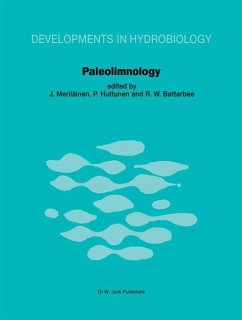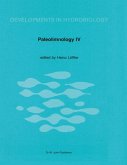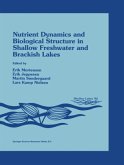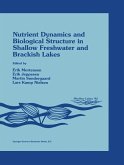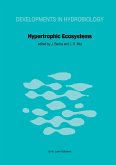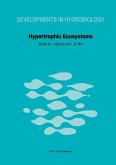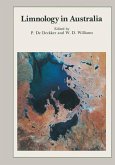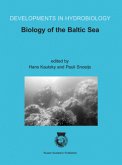MeriläinenProceedings of the Third International Symposium on Paleolimnology, held at Joensuu, Finland
Paleolimnology
Proceedings of the Third International Symposium on Paleolimnology, held at Joensuu, Finland
Herausgegeben:Meriläinen, J.; Huttunen, P.; Battarbee, R. W.
MeriläinenProceedings of the Third International Symposium on Paleolimnology, held at Joensuu, Finland
Paleolimnology
Proceedings of the Third International Symposium on Paleolimnology, held at Joensuu, Finland
Herausgegeben:Meriläinen, J.; Huttunen, P.; Battarbee, R. W.
- Gebundenes Buch
- Merkliste
- Auf die Merkliste
- Bewerten Bewerten
- Teilen
- Produkt teilen
- Produkterinnerung
- Produkterinnerung
The Third International Symposium on Paleolimnology was held at the beginning of September 1981 in Finland. After registration at the University of 10ensuu and the opening session and welcome reception in the Town Hall, the participants moved to a hotel at Koli, a hill famed as a landmark and for its panoramic view. Here the lecture session, lasting four days, took place. Momentarily, the mosaic of the lakeland became visible between the clouds showing the hill slopes covered by mature spruce forest and scattered old birch trees, a reminder of the last slash-and-burn phase some 130 years ago.…mehr
Andere Kunden interessierten sich auch für
![Paleolimnology IV Paleolimnology IV]() LöfflerPaleolimnology IV154,99 €
LöfflerPaleolimnology IV154,99 €![Nutrient Dynamics and Biological Structure in Shallow Freshwater and Brackish Lakes Nutrient Dynamics and Biological Structure in Shallow Freshwater and Brackish Lakes]() Nutrient Dynamics and Biological Structure in Shallow Freshwater and Brackish Lakes224,99 €
Nutrient Dynamics and Biological Structure in Shallow Freshwater and Brackish Lakes224,99 €![Nutrient Dynamics and Biological Structure in Shallow Freshwater and Brackish Lakes Nutrient Dynamics and Biological Structure in Shallow Freshwater and Brackish Lakes]() MortensenNutrient Dynamics and Biological Structure in Shallow Freshwater and Brackish Lakes231,99 €
MortensenNutrient Dynamics and Biological Structure in Shallow Freshwater and Brackish Lakes231,99 €![Hypertrophic Ecosystems Hypertrophic Ecosystems]() Hypertrophic Ecosystems77,99 €
Hypertrophic Ecosystems77,99 €![Hypertrophic Ecosystems Hypertrophic Ecosystems]() BaricaHypertrophic Ecosystems154,99 €
BaricaHypertrophic Ecosystems154,99 €![Limnology in Australia Limnology in Australia]() P. de DeckkerLimnology in Australia77,99 €
P. de DeckkerLimnology in Australia77,99 €![Biology of the Baltic Sea Biology of the Baltic Sea]() Hans Kautsky / Pauli Snoeijs (Hgg.)Biology of the Baltic Sea153,99 €
Hans Kautsky / Pauli Snoeijs (Hgg.)Biology of the Baltic Sea153,99 €-
-
-
The Third International Symposium on Paleolimnology was held at the beginning of September 1981 in Finland. After registration at the University of 10ensuu and the opening session and welcome reception in the Town Hall, the participants moved to a hotel at Koli, a hill famed as a landmark and for its panoramic view. Here the lecture session, lasting four days, took place. Momentarily, the mosaic of the lakeland became visible between the clouds showing the hill slopes covered by mature spruce forest and scattered old birch trees, a reminder of the last slash-and-burn phase some 130 years ago. Altogether 120 paleolimnologists participated in the meetings and most also attended one of the two post-symposium excursions to the Arctic Circle and to South Finland. The lectures covered a wide range of paleolimnological subjects. The main topics, however, included current aspects in the dating of sediments and the history of eutrophication. The symposium was advised by the international organizing committee under the presidency of Professor Edward S. Deevey. Other members present at Koli were Dr. Maj-Britt Florin, Dr. Heikki Ignatius, Prof. Heinz Lamer, Prof. Gerbert Martinson and Dr. Magdalena Ralska-lasiewiczowa. They also gave direction to a discussion on future plans for international activity in paleolimnology. Later in the autumn, after the end of the symposium, the partici pants sent special thanks to the secretaries, Mrs. Eija Merilainen, Mrs. Tuula Nylander and Mrs. Anita Toukomaa, for solving individual problems during the symposium with smooth and rapid efficiency.
Hinweis: Dieser Artikel kann nur an eine deutsche Lieferadresse ausgeliefert werden.
Hinweis: Dieser Artikel kann nur an eine deutsche Lieferadresse ausgeliefert werden.
Produktdetails
- Produktdetails
- Developments in Hydrobiology 15
- Verlag: Springer / Springer Netherlands
- Artikelnr. des Verlages: 978-90-6193-766-1
- Reprinted from HYDROBIOLOGIA, 103, 1983
- Seitenzahl: 328
- Erscheinungstermin: 30. September 1983
- Englisch
- Abmessung: 266mm x 200mm x 23mm
- Gewicht: 910g
- ISBN-13: 9789061937661
- ISBN-10: 9061937663
- Artikelnr.: 22923544
- Herstellerkennzeichnung
- Springer-Verlag GmbH
- Tiergartenstr. 17
- 69121 Heidelberg
- ProductSafety@springernature.com
- Developments in Hydrobiology 15
- Verlag: Springer / Springer Netherlands
- Artikelnr. des Verlages: 978-90-6193-766-1
- Reprinted from HYDROBIOLOGIA, 103, 1983
- Seitenzahl: 328
- Erscheinungstermin: 30. September 1983
- Englisch
- Abmessung: 266mm x 200mm x 23mm
- Gewicht: 910g
- ISBN-13: 9789061937661
- ISBN-10: 9061937663
- Artikelnr.: 22923544
- Herstellerkennzeichnung
- Springer-Verlag GmbH
- Tiergartenstr. 17
- 69121 Heidelberg
- ProductSafety@springernature.com
1. Opening lecture: Aspects of the developmental history and paleolimnology of lakes in Finland.- One: Methods and their Applications.- 2. Säynäjälampi and the difficulties inherent in the dating of sediments in a hard-water lake.- 3. The use of fallout 137Cs and 239,240Pu for dating of lake sediments.- 4. Caesium-137 profiles in the sediments of a partial-meromictic lake on Great Sandy Island (Fraser Island), Queensland, Australia.- 5. The assessment of 210Pb data from sites with varying sediment accumulation rates.- 6. Mineral magnetic studies on lake sediments: A brief review.- 7. Global holocene magnetostratigraphy.- 8. The use of magnetic measurements in interpreting the fire histories of lake drainage basins.- 9. Changing patterns of sediment accumulation in a small lake in Scania, southern Sweden.- 10. The use of X-ray radiographic methods in studying sedimentary properties and rates of sediment accumulation.- 11. An automated technique for the accurate positioning of sediment core sites and the bathymetric mapping of lake basins.- 12. Recent climatic changes recorded by the salinity of pore waters in the Dead Sea sediments.- 13. Trace element associations as indicators of sediment accumulation in lakes.- 14. Transfer functions for estimating paleoecological conditions (pH) from East African diatoms.- 15. Interpretation of lake quality from contemporary diatom assemblages.- 16. Bacterial decomposition of organic matter in lacustrine sediments.- 17. Relationship between sedimentary pigments and primary production: evidence from core analyses of twelve Italian lakes.- Two: Lake Changes Related To the Influence of Man.- 18. The mythical concept of eutrophication.- 19. Paleolimnological reconstruction of the effects of atmospheric deposition of acids and heavymetals on the chemistry and biology of lakes in New England and Norway.- 20. Cultural disturbances and trophic history of a small meromictic lake from central Canada.- 21. Diatom and chrysophyte relict assemblages in the sediments of Blelham Tarn in the English Lake District.- 22. Changes in the benthic fauna of the profundal zone of Traunsee (Austria) due to salt mining activities.- 23. Cladoceran remains as evidence of change in trophic state in three Swiss lakes.- 24. Changes in diatom flora deposited annually during the freshening of the impounded, sea-bay of Gennarbyviken in southern Finland.- 25. Eutrophication processes in Spanish reservoirs as revealed by biological records in profundal sediments.- 26. Seasonal eutrophication by wildfowl in basins isolating from the sea: A working hypothesis.- 27. Eutrophication and the disappearance of lakes in the Brodnica Lake District, Northern Poland as a result of human interference.- 28. An attempt to trace eutrophication in a shallow lake (Balaton, Hungary) using chironomids.- 29. Zn, P and ATP in the sediments of two lakes in South Finland.- 30. Clostridium perfringens (Holland) as an indicator of human effluent in the sediment of Lake Tuomiojärvi, central Finland.- 31. Paleolimnological studies of annually-laminated sediments in Loe Pool, Cornwall, U.K..- Three: Regional Paleolimnology.- 32. Recent geologic development of Lake Michigan (U.S.A.).- 33. Paleolimnology of the Peten Lake District, Guatemala I. Erosion and deposition of inorganic sediment as inferred from granulometry.- 34. Paleolimnology of the Peten Lake District, Guatemala II. Mayan population density and sediment and nutrient loading of Lake Quexil.- 35. Paleolimnology of the Peten Lake District, Guatemala III. Late Pleistocene and Gamblianenvironments of the Maya area.- 36. The Holocene development of some low and high arctic Greenland lakes.- 37. Palynological investigations of the sediments of ten lakes in eastern Holstein, North Germany.- 38. Development of Grossensee (Holstein, Germany): variations in trophic status from the analysis of subfossil microfauna.- 39. Stratigraphy of Cladocera and Chironomidae in a core from a shallow North German lake.- 40. Diatom succession in the post-glacial sediments of the Komo?any Lake, North-West Bohemia, Czechoslovakia.- 41. The environmental evolution and infilling process of a former lake near Vracov (Czechoslovakia).- 42. Variability of Actinocyclus kuetzingii (A.S.) Sim. in the Littorina sediments of the Polish Baltic Coast.- 43. Paleolimnological investigations in humid and arid zones of the Soviet Union.- 44. Recent history of Lake Ladoga.- 45. Diatoms in the plankton and sediments of two lakes of different trophic type.- 46. Palynological investigations of the sediments of the north-western lakes of the Russian Plain and the Baltic Sea.- 47. The Middle-Valdaj lakes in the western part of the Bolshezemelskaja tundra.- 48. Sediment formation in Lake Baikal.- 49. Recent stratigraphy and accumulation of sediment in the deep, oligotrophic Lake Pääjärvi in South Finland.- 50. Biostratigraphy of Lake Spitaalijärvi: an ultraoligotrophic small lake in Lauhanvuori, western Finland.- 51. Sysmäjärvi - a lake polluted by mining waste-water.- 52. Sedimentary chemistry of a small polluted lake, Gallträsk, S. Finland.
1. Opening lecture: Aspects of the developmental history and paleolimnology of lakes in Finland.- One: Methods and their Applications.- 2. Säynäjälampi and the difficulties inherent in the dating of sediments in a hard-water lake.- 3. The use of fallout 137Cs and 239,240Pu for dating of lake sediments.- 4. Caesium-137 profiles in the sediments of a partial-meromictic lake on Great Sandy Island (Fraser Island), Queensland, Australia.- 5. The assessment of 210Pb data from sites with varying sediment accumulation rates.- 6. Mineral magnetic studies on lake sediments: A brief review.- 7. Global holocene magnetostratigraphy.- 8. The use of magnetic measurements in interpreting the fire histories of lake drainage basins.- 9. Changing patterns of sediment accumulation in a small lake in Scania, southern Sweden.- 10. The use of X-ray radiographic methods in studying sedimentary properties and rates of sediment accumulation.- 11. An automated technique for the accurate positioning of sediment core sites and the bathymetric mapping of lake basins.- 12. Recent climatic changes recorded by the salinity of pore waters in the Dead Sea sediments.- 13. Trace element associations as indicators of sediment accumulation in lakes.- 14. Transfer functions for estimating paleoecological conditions (pH) from East African diatoms.- 15. Interpretation of lake quality from contemporary diatom assemblages.- 16. Bacterial decomposition of organic matter in lacustrine sediments.- 17. Relationship between sedimentary pigments and primary production: evidence from core analyses of twelve Italian lakes.- Two: Lake Changes Related To the Influence of Man.- 18. The mythical concept of eutrophication.- 19. Paleolimnological reconstruction of the effects of atmospheric deposition of acids and heavymetals on the chemistry and biology of lakes in New England and Norway.- 20. Cultural disturbances and trophic history of a small meromictic lake from central Canada.- 21. Diatom and chrysophyte relict assemblages in the sediments of Blelham Tarn in the English Lake District.- 22. Changes in the benthic fauna of the profundal zone of Traunsee (Austria) due to salt mining activities.- 23. Cladoceran remains as evidence of change in trophic state in three Swiss lakes.- 24. Changes in diatom flora deposited annually during the freshening of the impounded, sea-bay of Gennarbyviken in southern Finland.- 25. Eutrophication processes in Spanish reservoirs as revealed by biological records in profundal sediments.- 26. Seasonal eutrophication by wildfowl in basins isolating from the sea: A working hypothesis.- 27. Eutrophication and the disappearance of lakes in the Brodnica Lake District, Northern Poland as a result of human interference.- 28. An attempt to trace eutrophication in a shallow lake (Balaton, Hungary) using chironomids.- 29. Zn, P and ATP in the sediments of two lakes in South Finland.- 30. Clostridium perfringens (Holland) as an indicator of human effluent in the sediment of Lake Tuomiojärvi, central Finland.- 31. Paleolimnological studies of annually-laminated sediments in Loe Pool, Cornwall, U.K..- Three: Regional Paleolimnology.- 32. Recent geologic development of Lake Michigan (U.S.A.).- 33. Paleolimnology of the Peten Lake District, Guatemala I. Erosion and deposition of inorganic sediment as inferred from granulometry.- 34. Paleolimnology of the Peten Lake District, Guatemala II. Mayan population density and sediment and nutrient loading of Lake Quexil.- 35. Paleolimnology of the Peten Lake District, Guatemala III. Late Pleistocene and Gamblianenvironments of the Maya area.- 36. The Holocene development of some low and high arctic Greenland lakes.- 37. Palynological investigations of the sediments of ten lakes in eastern Holstein, North Germany.- 38. Development of Grossensee (Holstein, Germany): variations in trophic status from the analysis of subfossil microfauna.- 39. Stratigraphy of Cladocera and Chironomidae in a core from a shallow North German lake.- 40. Diatom succession in the post-glacial sediments of the Komo?any Lake, North-West Bohemia, Czechoslovakia.- 41. The environmental evolution and infilling process of a former lake near Vracov (Czechoslovakia).- 42. Variability of Actinocyclus kuetzingii (A.S.) Sim. in the Littorina sediments of the Polish Baltic Coast.- 43. Paleolimnological investigations in humid and arid zones of the Soviet Union.- 44. Recent history of Lake Ladoga.- 45. Diatoms in the plankton and sediments of two lakes of different trophic type.- 46. Palynological investigations of the sediments of the north-western lakes of the Russian Plain and the Baltic Sea.- 47. The Middle-Valdaj lakes in the western part of the Bolshezemelskaja tundra.- 48. Sediment formation in Lake Baikal.- 49. Recent stratigraphy and accumulation of sediment in the deep, oligotrophic Lake Pääjärvi in South Finland.- 50. Biostratigraphy of Lake Spitaalijärvi: an ultraoligotrophic small lake in Lauhanvuori, western Finland.- 51. Sysmäjärvi - a lake polluted by mining waste-water.- 52. Sedimentary chemistry of a small polluted lake, Gallträsk, S. Finland.

